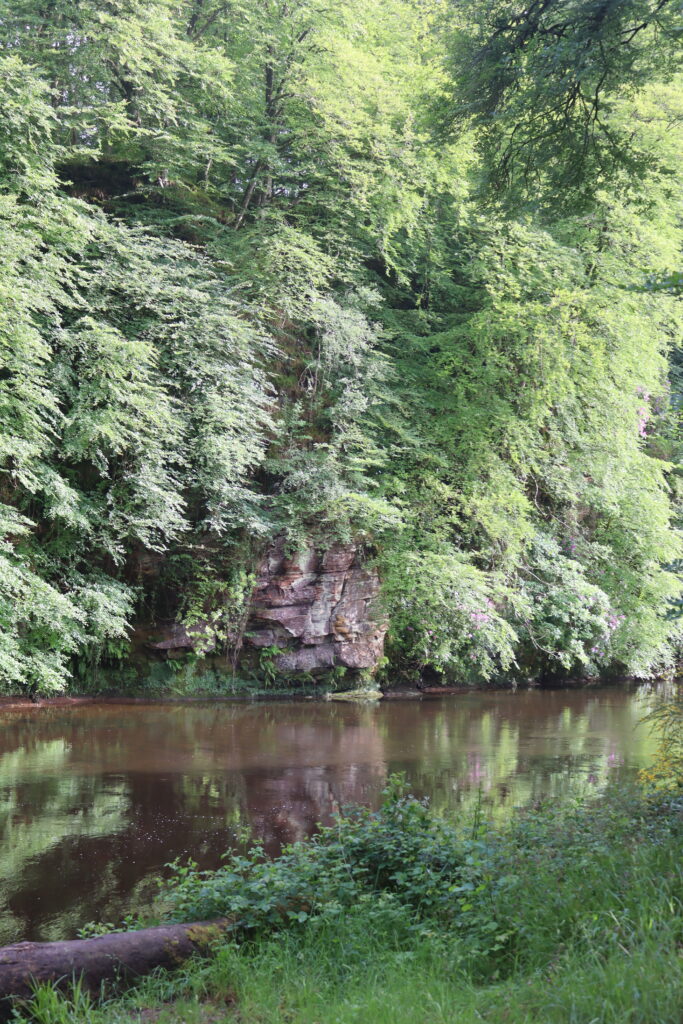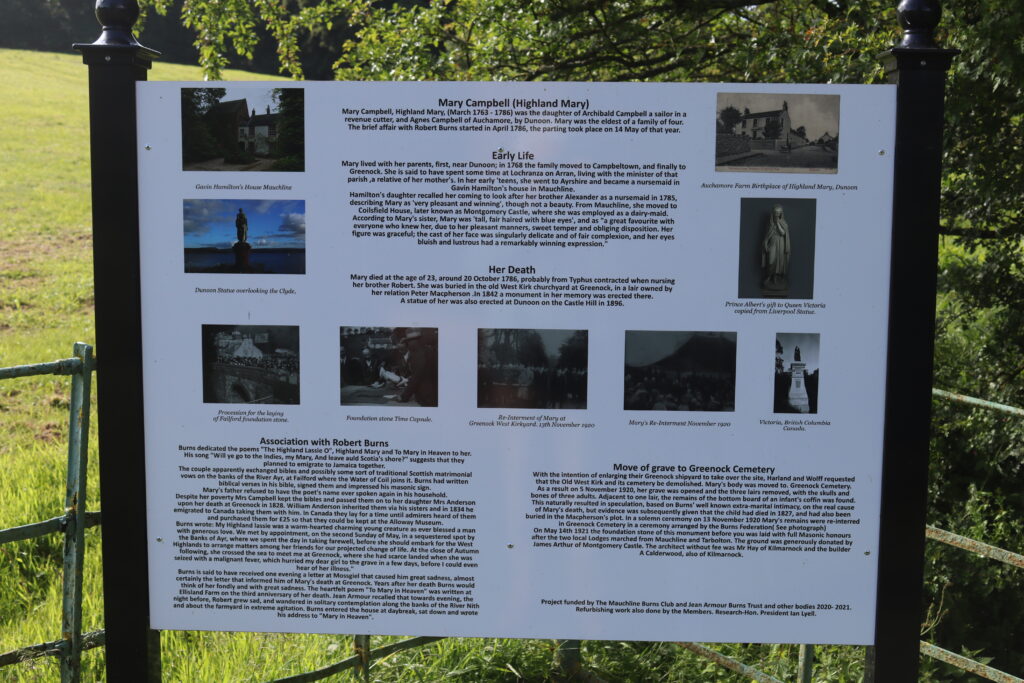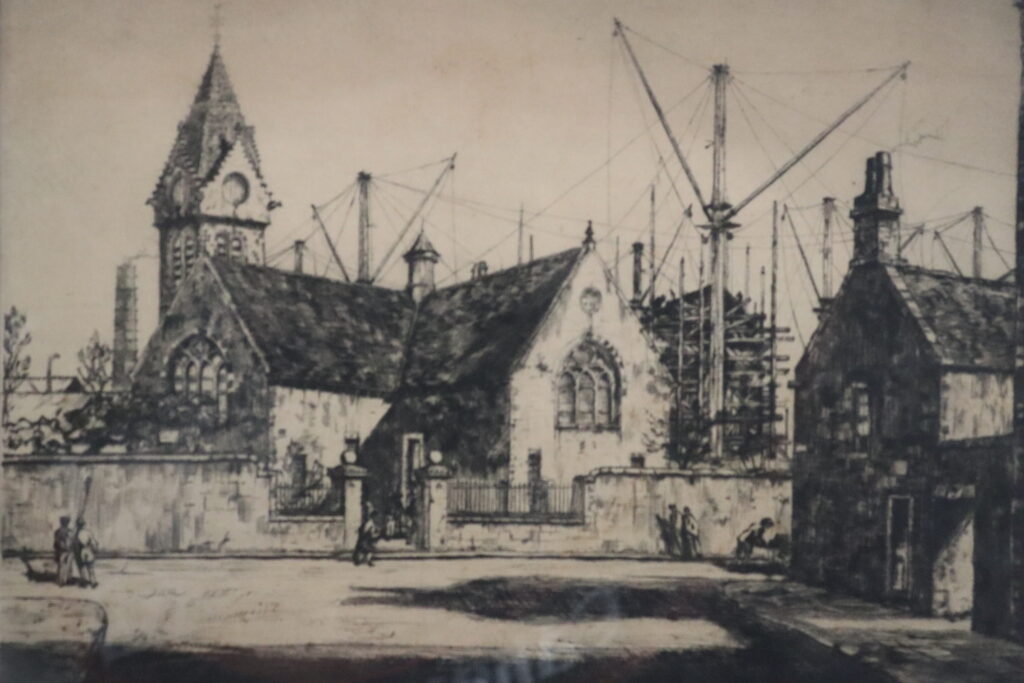
It was travelling en route to Mauchline on the Ayr road that I first saw the sign to the Highland Mary Monument. This was in the hamlet of Failford. On retracing my steps a few days later, I duly parked up with no difficulty just beyond the Failford Inn and walked down to the path which led up to the monument.

Robert Burns had met ‘Highland Mary’ (Mary Campbell (1763-1786)) in April 1786 and they parted company on the second Sunday in May (14th) of the same year, probably at a spot close by the monument. This was likely on the banks of the scenic River Ayr where the Water of Coil joins it.

Burns had plans to transport himself into the West Indies, and it is likely that he encouraged Mary to join him in this venture. Burns would later write that Mary had taken leave of him to arrange affairs with friends and family for their ‘projected change of life’ and with an intention to meet up in the autumn in Greenock, though soon after her arrival there she is thought to have contracted Typhus and died around 20th October 1786. There is an account of her nursing her brother in Greenock who was unwell.
Burns had an on-going relationship with Jean Armour of Mauchline and who would subsequently be delivered of twins in September that year. Jean Armour’s father, however, opposed their intended marriage and Burns had for a time thought that their relationship had foundered. The subsequent success of his Kilmarnock edition of his ‘Poems, Chiefly in the Scots Dialect’ allowed him to remain in Scotland. Jean Armour gives a revealing account of how Burns later struggled to cope on the anniversary of the death of Mary Campbell some three years later and after Jean Armour and Burns had eventually married.
On a recently installed panel behind the monument itself is a detailed account of the historical associations involved and which gives an account of the threads of history based on local lore and tradition.

Mary was originally buried in the cemetery of the original site of the Auld West Kirk in Greenock. An illustration in the McLean Museum in Greenock shows the church straddled by the shipyard that would eventually occupy the church site.

Her grave was removed with significant ceremony to the Greenock Cemetery in 1920 due to expansion of the Hartland and Wolfe shipyard, under the monument created previously by John G. Mossman.
The associations of Burns and ‘Highland Mary’ are often the subject of debate in an effort to obtain ‘the real story’ of their involvement. The poem ‘To Mary in Heaven’ by Robert Burns, however, conveys his enduring thoughts long after their parting.
I enjoyed your writing. Burns is a family name that pops up in my ancestry and I have been trying to see if I can trace it back to Robbie Burns. Any suggestions on where I can look for lineage, other than pay for Ancestry.com’’s international files? Thanks April
Thanks for your comment. One approach would be to obtain a copy of ‘The Bard’ by Robert Crawford and from the detailed biography list the immediate surviving descendents and trace through the list. In the scale of things I would only be a ‘novice’ when it comes to the lore of Burns, and there are others who are much more knowledgeable. One line of contact would be through the Irvine Burns Club with contact email honsecy@irvineburnsclub.org who may be able to assist by way of other contacts or relevant documentation.
Hope this is helpful.
Have you heard of Scotland’s People? This is the official online government family research website.
ScotlandsPeople is a very user friendly web site. Quite simple to use, but with a large array of specific search engines. You join the site, buy some search credits and just work at it at your own pace:)
Start with what you definitely know. I.e. mum and dad/ aunts and uncles. Research your ancestors using census, birth and death records in your own country back to when they arrived by boat from Scotland. Try and get the name of the boat and date they arrived in your own country. Then start searches in our Scotlands People Web site:-
https://www.scotlandspeople.gov.uk/?gclid=EAIaIQobChMIjPae3fa6_gIVCA-zAB1eYwF4EAAYASAAEgKbzvD_BwE
Take your time at it and work slowly at first until you get the hang of it. Maybe start with your facts detailed above and work back using census, births, marriages and deaths. If you have already found the ship they landed in your own country, that’s a great start for searching in Scotland’s People. Then just continue as you did in your home searches, but in Scotland’s People. It really becomes quite fascinating as you are finding such personal links to your antecedents. Just go for it!
Happy hunting:)
🏴🥃🏴
Thanks for the useful feedback.